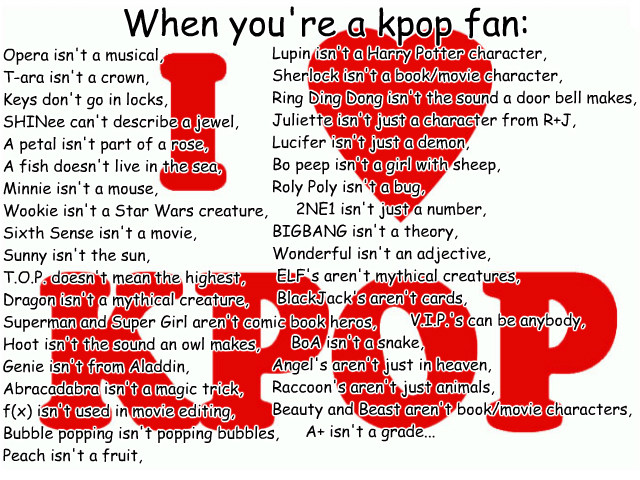When I was thinking about our assignment for artifacts related to my topic, I thought about using words. Words every K-Pop fan learns as they become immersed in the exciting world of K-Pop and in turn they start using with other K-Pop fans. But then I wondered, how would that work? Would they have to be relevant to only today’s audience? Would they be words that are still being used and their meanings have changed? In English, we are constantly modifying the way we speak and changing the meaning of words. Take the word gay for example. This word started out a meaning joyful, carefree and happy. In the 17th century it changed to mean addicted to pleasures. In the 19th century the meaning changed again. It now mean a woman who was a prostitute and a gay man was man who slept with a lot of women, usually prostitutes. It wasn’t until the 1920s and 1930s that this word changed to mean homosexual. As you can see the word is an artifact of sorts and at the same time it represents the different cultures that used the words. Just like any subject area, even K-Pop has its own jargon that the fans used. The K-Pop jargon reflects the Korean culture while at the same time separates the fans from the non-fans. In this post, I’ll explain some commonly used words.
- Oppa (oh-pa)/Hyung (h-young) – These words are used to refer to male artists who are older than the speaker. Oppa is what females would say and hyung males. They are used either as terms of endearment or to show a close relationship. Fans use them to flirt and show affection.
- Noona (nu-na)/Unnie (uh-ni)- The same as Oppa/hyung except used to refer to female artists who are older than the speaker. Noona is used by males and Unnie used by females.
- Aegyo (eh-g-yo) – when the artist is acting cute and showing their charms. This is done by both male and female artists
- Comeback – When the artist returns with a new project (song/album, drama, etc.)
- Sasaeng – a super obsessed fan who goes over the top when showing their love for their artist (e.g. following them around in a taxi all day, stalking, etc.)
- Daebak – awesome, wow, great
- Maknae – the youngest (whether in a situation family or in terms of the group members age)
- All-kill – when an artist/s reach number 1 on all (Korean) digital music charts
- Netizens – internet citizens
- Skinship – when the artist shows affection to its members or other artists
- Idol – what most k-pop artists are referred to since they are trained to be performers and uses their looks and appearance to earn money (opinion of the Korean public)
- Artist – those who use their musical talent to add depth and meaning to their music. also used interchangeably with idol. (has more respect than idol from the Korean public)

